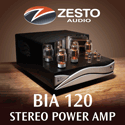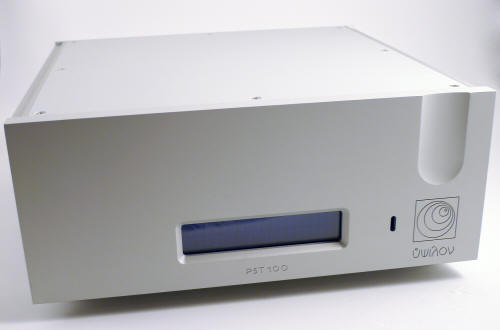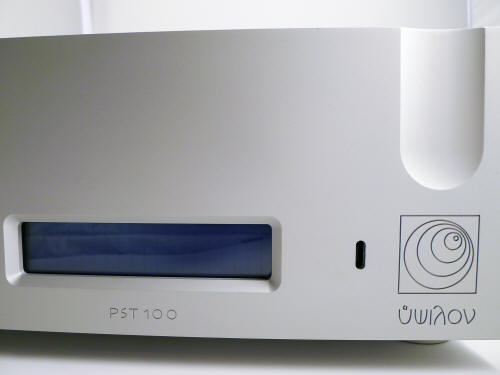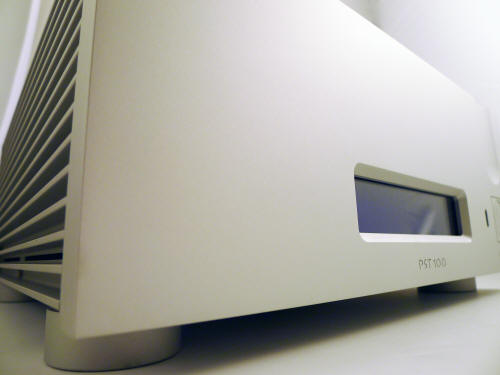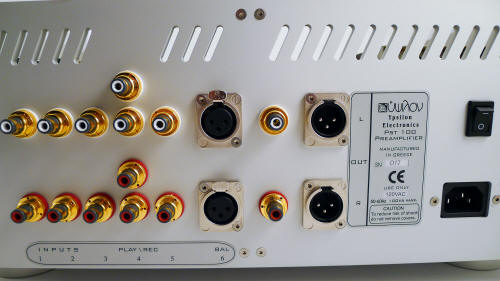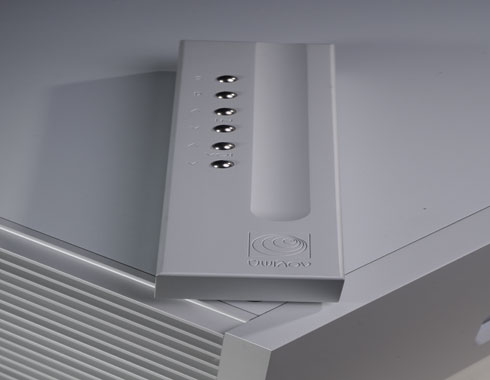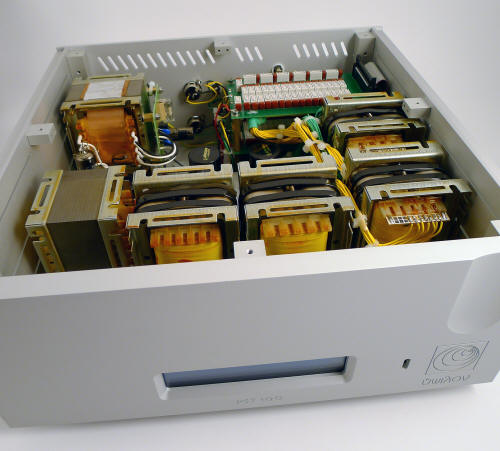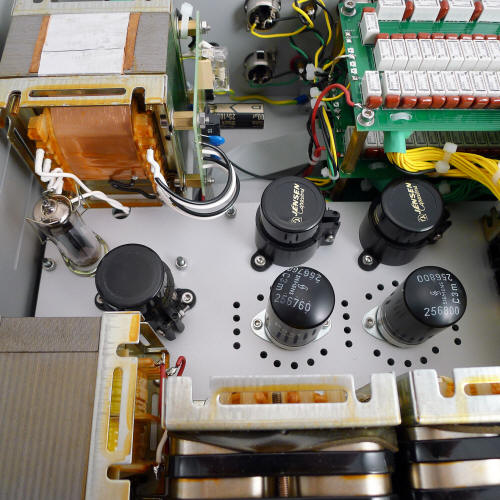|
|
You are reading the older HTML site
Positive
Feedback ISSUE 74
ypsilon PST 100MKII Preamplifier as reviewed by Marshall Nack
Before I slip on the green eyeshade, I want to compliment the Ypsilon PST 100 Preamp on the sheer creature comfort of its musical presentation. I had almost forgotten such a thing existed in the land of Hi-Fi. Wow! This preamp is pushing a lot of buttons. But it didn't start out that way. Before its splendor was revealed—despite having been used at recent shows—the PST 100 needed more than a week of gestational burn-in. For that matter, if I swapped it out for any length of time, a mini burn-in of at least a day was necessary when it went back in. (The importer pointed out there would be long burn-ins, due to the half-dozen transformers inside and all those windings.)
The PST 100 is a simple machine, as simple as is feasible for the job at hand. The design philosophy follows both the Japanese model and the minimalist approach with short signal paths and only a pair of C3m tubes in front of the signal—minimalism taken to the extreme. (There is also a 6CA4/EZ81 valve for rectification.) Beyond input selection and volume attenuation, the only additional feature is a choice of passive or active modes of operation. (A passive-only preamp called the PST 100 TA is available for $26,000. My sample had both modes, MSRP $37,000.) Setup Options Post burn-in, I started with my Accuphase DP-600 SACD player connected to the preamp's balanced inputs. This never gelled. (Maybe even more burn-in was needed? I didn't pursue it.) I switched to the S-E inputs and got much better results. Next I explored the preamp's passive mode and went through the input choices again. Passive mode sounded off; I was later told this mode inverts phase. You see, it was not as simple as plug-n-play: I had to methodically work through the options. Optimum playback was achieved with single-ended connections on both sides and active mode; this was used for the balance of the audition. Step-Up Transformers: Musical Flow Let's begin with Mozart Symphony No. 38, with Charles Mackerras and the Scottish Chamber Orchestra (Linn CKD 308, SACD).
Right away I knew there were step-up transformers in the signal path. Step-ups are a hot button: depending on your preferences, they could be a positive or a negative (or both). In my book, if you can get past the negatives—compromised macro dynamics and speed, truncated treble extension—step-ups can bring major positives to bear. The PST 100 manages to hold those downsides in check, while the positives are evidenced in all their glory, namely the expert capture of music's ebb and flow, the way it makes sense of the succession of notes over time. The PST 100's waveform is a continuous line as the music unfolds, connecting the dots and communicating the subtle ways the musician shapes the note or phrase. In my experience, step-ups are masterful at getting these dynamic relationships correct. (I'm familiar with the step-up effects; there are other transformers inside that may be contributing.) Step-ups also impact image shape. When a system projects fixed, appropriately sized images that are firmly planted on the earth, it is a huge positive. Building upon that, if they are able to dance a little it is even better. What you don't want is images that are massive, granitic tombstones forming a cemetery-like soundstage. The PST 100 images hold to fixed locations and tend to be oversized but, importantly, they are not static. They are flexible—their shape changes depending on the instrument and what part of its range it is playing in. For example, a flute in its upper register images as a point source, but when it plays lower it spreads, and at no time does its image resemble a bassoon's. The PST 100 conveys image shapes that are variable and correctly sized in relation to each other. Tubes: Timbral Finesse I also could tell there were valves at work because of the timbres. At this level of gear, you expect timbre to be well done; what the PST 100 does was something else again. Many components convey the signature of each instrument making for easy ID. But after you hear the PST 100, a subtle awareness dawns that they are carrying over much of the timbral palette from one instrument to the other. The PST 100 palette encompasses a veritable rainbow of shadings and it portrays each instrument uniquely . They all sound different. Listener Satisfaction Here's the scoop: What the PST 100 does with instrument shape, timbre, and musical flow imparts rare fidelity. It captures the essence of the instrument and is a joy to hear, even if it's a little beyond what you might hear live. I imagine this is what a high-purity, low-noise, transformer-coupled, tube-hybrid design in its idealized form should sound like. It sits very comfortably on the ear.
There were occasions, especially when paired with Ypsilons' own Aelius monoblocks, when the sheer beauty of the sound was like being in the best concert venue with the best musicians on stage—at the flip of a switch. The subjective part of me is digging this holistic thing like crazy. But the objective part is saying, "If it's consistently engaging and beautiful—how can that be accurate? Reality is not like that, right?" Nowadays, people regard these things as "musical colorations." OK, everyone acknowledged they were present. However, few found they got in the way. On the contrary, the majority of my panel found it added to their enjoyment. A Well-behaved Soundstage One of the giveaways that you're listening to a stereo system is the tendency for the soundstage to move around in tandem with SPL. When the music gets louder, the stage comes forward. And components react badly to peak signals, acquiring distortion byproducts: frequency response shifts towards the treble; the sound hardens. None of this happens with the PST 100. Its stage forms at the speakers, recedes from there and does not budge. The front line stays at the plane of the speakers and tonal balance and sound quality remain the same as the orchestra crescendos. The PST 100 retains its composure at all times. The soundstage presented is highly dimensional, very wide and layered in depth. Everything is located just where you would expect it to be—an unambiguous space. Images have lots of air around them. There are no sharp image borders, no sharp anything. The overall stage has a soft quality. No one will accuse the PST 100 of being etched: it has a holistic, blended feel. You locate instruments by their timbre. It is remarkably well-behaved, if a bit laid back. The PST 100 stage does not POP like some of the solid-state preamps I've had in lately. It reminds me of rear parquet or first tier at Carnegie Hall, an ideal soundstage for classical music listening. This is how sound behaves in large spaces. Many listeners prefer this. Given these qualities, the power of the PST 100 macros surprised me. They did not give up anything to the wondrous Trinity Preamp. (The Audionet DNP was another thing entirely, as far as dynamic range and punch.) Nor did it fall short in detail retrieval in that comparison. The amount of information presented was right up there, as well.
Tonal Balance Tonal balance comes in slightly lighter than my Trinity Preamp and about the same as the Audionet DNP. The treble is extended and sweet, with a slightly soft leading edge; the midrange is clear and lively, with tons of inner life; the bass goes low, but not with as much authority as some of the solid-state competition. It could be tighter and have more texture. Overall, the frequency sweep is linear, with lots of body and flesh, and a tad warm. Ancillary System When new gear comes in, I go through a simple checklist to optimize performance, such as adding or removing weights for mass loading or damping. (I never put weights on top of a component; always under it, on the shelf.) Or I might turn on my TARA Labs IDAT power conditioner, which affects the AC even when out of the signal path and provides additional buffering. (This is a legacy piece—the days of active conditioning for me are long gone. It's an excellent fine tuning tweak. Although expensive and large for the purpose, sometimes it's just what is needed.) The Ypsilon went onto my TAOC rack with Kubala•Sosna Elation! cables and power cord and did its thing; it didn't need any tweaking, it sounds incredibly open with no lack of control just as it is. Amplifiers used with the PST 100 included the CH Precision A1, the Audionet AMP monoblocks and the Ypsilon Aelius, all via S-E connection. All three were synergistic pairings: The PST 100/Audionet AMPs produced very high quality sound at a relatively bargain price. The PST 100 with the Aelius had guys tossing around "end of the journey" assessments. Cosmetics The PST 100 is a big, tall, and deep box. The front panel looks like a variant of the Swiss and German components that have passed through lately, such as the Soulution 710, the CH Precision C1 and the Audionet DNP: an unadorned, thick aluminum plate with a black display window to monitor various functions. The Ypsilon logo etched along the right side adds a nice, understated elegance. That's the extent of the similarity though: the side panels have vents, the top has exposed screw heads, and the rear has a decidedly old school look about it.
Except there are no controls on the main chassis, there is no computer inside, and no buttons or menu system. It has no memory—when you power up the PST 100, it will always go to Input 1 and Volume 00. Everything is done from the remote control. The few selectable options include mode (active or passive), volume, and input selection. Input 3 is labeled Tuner; Input 2 is Phono. These labels are fixed. The lack of controls on the chassis was inconvenient. It meant that I had to carry the remote with me—a large and heavy block of aluminum—every time I changed a record.
Construction The PST 100 chassis is fabricated in Germany; everything else is made in-house in Greece the old-fashioned way—by hand. A key aspect of the design is the volume control. Where most designers use resistors, Ypsilon accomplishes volume attenuation by means of a very special, in-house manufactured transformer attenuator with 31 taps. It is claimed to be ultra linear, less grainy and discontinuous compared with even the best resistors.
The buzz is that the secret of the Ypsilon sound is their transformers. They are painstakingly hand-wound, a tedious, time-consuming task that has to be done just right, else it is thrown out. They're in every product and the PST 100 has six inside. Other firms have inquired if Ypsilon would source their transformers—no way! The secret will not be revealed. The PST 100 needs a good hour with signal to sound its best. If you opt to leave it on 24/7, the tubes have a life expectancy of 10,000 hours and will be good for about two years. Premium replacement tube sets are available through your dealer.
Conclusion Looking for a rich, full, resonant sound, as opposed to a focused, analytic one? Look no further. "Man, what a natural, refined sound!" was the panel's enthusiastic verdict on the Ypsilon PST 100 Mk II Preamp. This design extracts the maximum benefits from its step-up and tube-hybrid topology and has that rare ability to convey humans upon the stage. While "musical colorations" are present—no one would dispute that—they are minor in degree and don't get in the way. Instead, they add just the right amount of creature comfort, stuff that was missed when I swapped in alternate preamps . The PST 100 is also excellent on the objectivist side of the ledger in terms of dynamics, resolution, frequency linearity, low noise, etc. Here's the scoop: For those who are looking for a little bit of creature friendliness served up along with excellent grades on the audio scorecard, you'd be hard pressed to find better than the PST 100 Mk II at any price. Marshall Nack
PST 100
Mk II Preamp
Ypsilon
Electronics Importer
Aaudio
Imports
|






